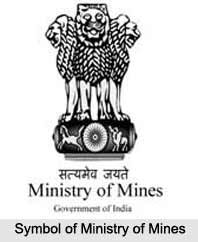 Ministry of Mines is responsible for survey and exploration of all minerals, other than natural gases, petroleum and atomic minerals, for mining and metallurgy of non-ferrous metals like aluminium, copper, zinc, lead, gold, nickel, etc. It is also responsible for the administration of the Mines and Minerals (Regulation and Development) Act, 1957 in respect of all mines and minerals other than coal, natural gas and petroleum.
Ministry of Mines is responsible for survey and exploration of all minerals, other than natural gases, petroleum and atomic minerals, for mining and metallurgy of non-ferrous metals like aluminium, copper, zinc, lead, gold, nickel, etc. It is also responsible for the administration of the Mines and Minerals (Regulation and Development) Act, 1957 in respect of all mines and minerals other than coal, natural gas and petroleum.
Organisation of Ministry of Mines
The Secretariat of the Ministry of Mines is headed by the Secretary to Government of India and includes other officers viz Additional Secretary, two Joint Secretaries, one Joint Secretary and Financial Adviser (common for Ministries of Coal, Ministry of Mines and Ministry of Youth Affairs and Sports), nine Directors / Deputy Secretaries, five Under Secretaries, one Junior Scientific Officer, twenty-five Section Officers, one Assistant Librarian and Information Officer in addition to a Joint Director and Assistant Director each for Official Language. Beside this, this Ministry has one Development Officer. The total number of sanctioned posts for the Secretariat of the Ministry of Mines is 60 Gazetted and 169 Non-Gazetted. In addition, there is a Chief Controller of Accounts assisted by a Pay and Accounts Officer and Assistant Accounts Officer and 31 Non-Gazetted Staff in the Pay & Accounts Office.
The Geological Survey of India is an attached office and Indian Bureau of Mines is a subordinate office of the Ministry. There are four Public Sector Undertakings under the Ministry of Mines namely National Aluminium Company Limited (NALCO), Bhubaneswar; Hindustan Copper Limited (HCL), Kolkata; Mineral Exploration Corporation Limited(MECL), Nagpur; Bharat Gold Mines Limited (BGML), Kolar Gold Fields (Karnataka). There are three Institutions which are Autonomous Bodies of this Ministry namely Jawaharlal Nehru Aluminium Research Development and Design Centre (JNARDDC) Nagpur; National Institute of Rock Mechanics, (NIRM) Kolar; and National Institute of Miners` Health (NIMH), Nagpur.
In addition a registered Society, namely the Non-ferrous Materials Technology Development Centre, Hyderabad (NFTDC ) a non-grant institution came within the administrative purview of the Ministry during the year as a consequence to the election of Secretary ( Mines) as the Chairman of the General Body of the Centre in place of the Scientific Advisor, D.R.D.O
Functions of Ministry of Mines
Ministry of Mines is responsible for survey and exploration of all minerals, other than natural gases, petroleum and atomic minerals; for mining and metallurgy of non-ferrous metals like aluminium, copper, zinc, lead, gold, nickel etc. It sees to the administration of the Mines and Minerals (Development and Regulation) Act, 1957 in respect of all mines and minerals other than coal, natural gas and petroleum. Among the various functions allotted to the Ministry and the various offices under its administration are:
(a) Legislation for regulation of mines and development of minerals within the territory of India, including mines and minerals underlying the ocean within the territorial waters or the continental shelf, or the exclusive economic zone and other maritime zones of India as may be specified, from time to time by or under any law made by Indian Parliament.
(b) Regulation of mines and development of minerals other than Coal, Lignite and Sand for stowing and any other mineral declared as prescribed substances for the purpose of the Atomic Energy Act, 1962 (33 of 1962) under the control of the Union as declared by law, including questions concerning regulation and development of minerals in various States and the matters connected therewith or incidental thereto.
(c) All other metals and minerals not specifically allotted to any other Ministry/Department, such as Aluminium, Zinc, Copper, Gold, Diamonds, Lead and Nickel.
(d) Planning, development and control of, and assistance to, all industries dealt with by the Ministry.
(e) Geological Survey of India
(f) Indian Bureau of Mines
(g) Metallurgical Grade Silicon.






